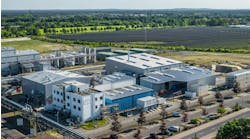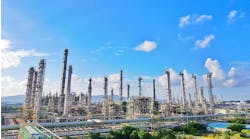In 2005, a Michigan-based global petrochemical company that manufactures diverse products ranging from plastics to specialty chemicals established a goal of improving its energy efficiency by 25% by the year 2015. To meet these goals, employees at the company's Louisiana site were well aware they needed to act decisively to control energy waste. This column highlights their successful efforts.
[pullquote]
POTENTIAL PROJECT AREA
Steam is the most significant energy utility at the Louisiana site. The site produces steam for distillation, evaporation, concentration, process heating and catalytic cracking, besides electricity generation. Plant personnel, in conjunction with the U.S. Department of Energy (DOE), conducted a steam system energy savings assessment. The DOE's steam system assessment tool (SSAT) identified seven energy-savings opportunities and evaluated "what if" implementation scenarios for optimal energy savings. Natural gas cost $7.25 per MM Btu during the assessment period.
Four of the energy-savings opportunities were classified as near-term opportunities and are briefly described below.
Implement a steam trap repair project. A recent steam trap survey identified all failing steam traps. Entering the number of failed traps at the different pressure headers into the SSAT and modeling the impact of implementing a steam trap repair project generated an accurate estimate of steam leakage stemming from the failed traps. Annual savings in natural gas and costs were estimated to be 112,128 MMBtu and $881,000, respectively.
Increase condensate recovery. At the time of the assessment, only about 50% of steam condensate was recovered from the low-pressure (LP) steam users. Based on analysis of LP steam users that are mixing steam directly with the process, about 80% of the LP steam use at the entire site was recoverable. A condensate recovery rate of 75% is possible by fixing issues such as excessive back pressure in return lines and failed condensate pumps. The increased condensate recovery would result in an estimated natural gas and cost savings of 87,600 MMBtu and $649,000.
Improve insulation. A plant inspection pinpointed several areas of the steam distribution network that lacked sufficient insulation. Using 3EPlus, DOE's insulation calculation program, the team estimated total insulation losses to be approximately 1%. By reducing these insulation losses to 0.1%, the assessment showed that annual natural gas and cost savings of 3,030 MMBtu and $25,000 could be achieved.
The fourth near-term opportunity was to fix the observed steam leaks.
Three other savings opportunities — ones classified as medium term — also were identified:
Install a blowdown heat recovery exchanger. Although the blowdown water from the high pressure boilers was sent to a flash tank to recover LP steam, draining the blowdown water resulted in the loss of significant amounts of thermal energy. Installing a heat recovery exchanger upstream of the blowdown tank could recover substantial heat from the blowdown water and could be used to preheat boiler makeup water. The assessment estimated annual natural gas and cost savings at approximately 31,000 MMBtu and $200,000.
Preheat reactor feed with 75-psig steam. The assessment found that some of the heat needed to preheat the reactor feed from ambient to reaction temperatures could be supplied by 75-psig steam instead the 600-psig steam generated at the site. While this opportunity wouldn't save natural gas, it would allow additional electricity generation from the 600-psig steam that wasn't being used to preheat the reactor feed. This could reduce electricity purchases, leading to estimated annual electricity and cost savings of 1,277 MWh and $79,000.
Install a back-pressure turbine drive: Although the site generates steam at 600 psig, most applications require steam at 200 psig. Installing a back-pressure turbine drive could generate enough electricity to serve some of the plant's specific critical powered equipment. Annual electricity and cost savings were estimated at 1,946 MWh and $121,000.
Site management implemented two of the four near-term measures. The steam trap retrofit resulted in an annual energy savings of 109,000 MMBtu and energy cost savings of approximately $792,000. The steam leak repairs provided an annual energy savings of 163,000 MMBtu, worth a little more than $1.1 million. Total annual energy and energy cost savings were 272,000 MMBtu and $1.9 million, respectively. With total implementation costs of approximately $225,000, simple payback was slightly more than six weeks.
VEN V. VENKATESAN is Chemical Processing's Energy Columnist. You can e-mail him at [email protected]



